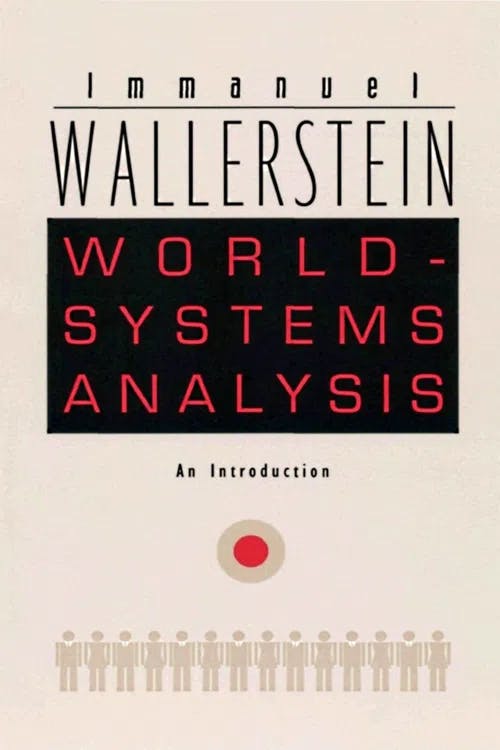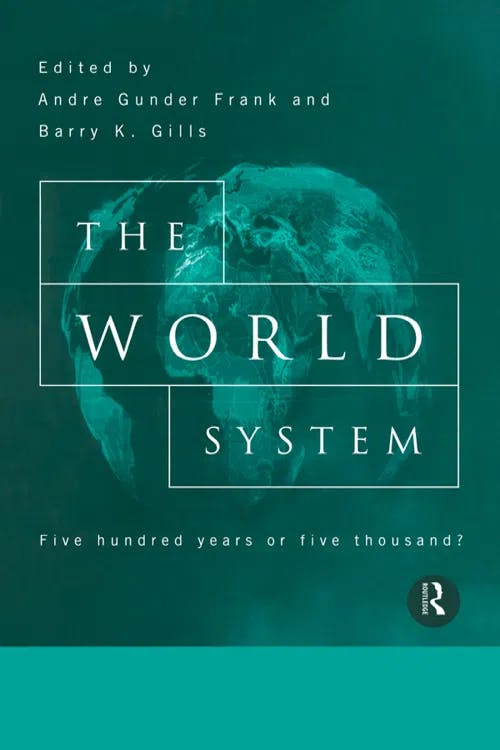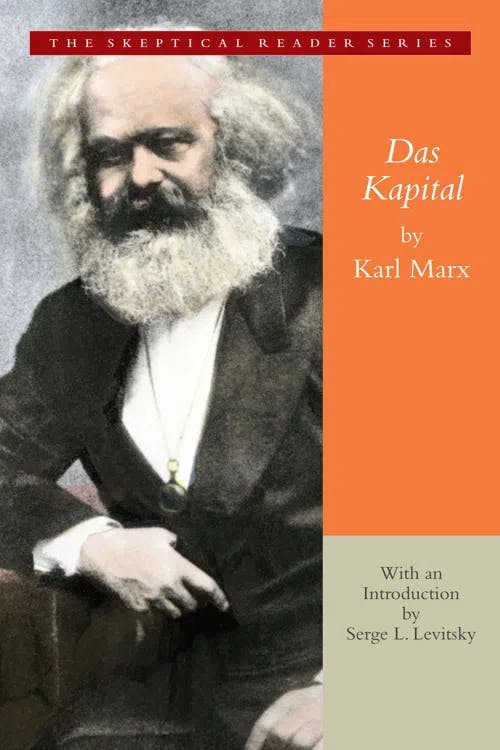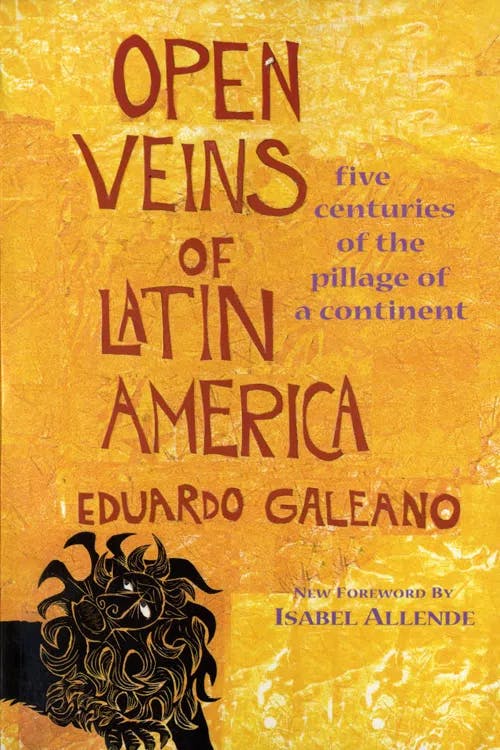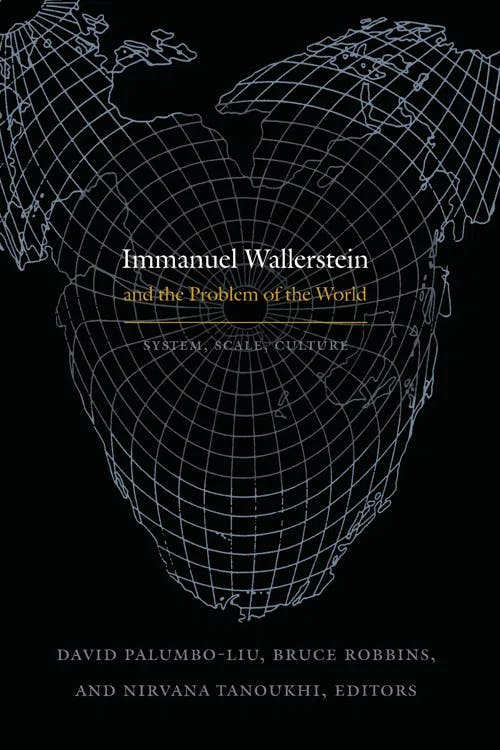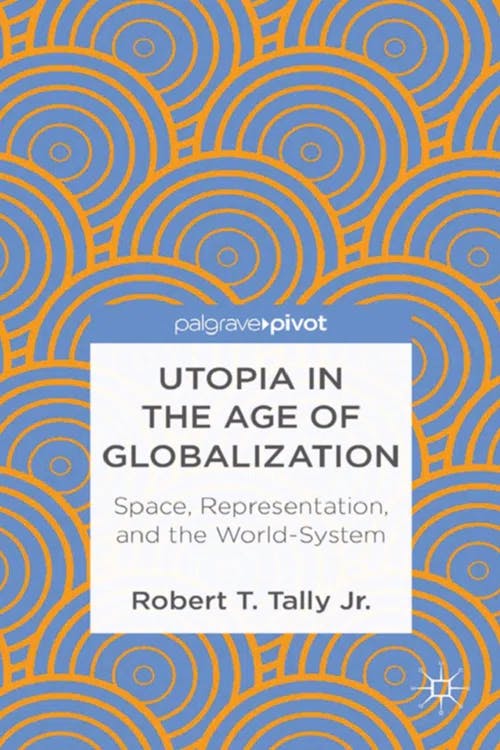What is World-Systems Theory?
MA, Sociology (Freie Universität Berlin)
Date Published: 04.05.2023,
Last Updated: 07.12.2023
Share this article
Defining world-systems theory
World-systems theory is an analytical method for understanding history and social change. It suggests that change is driven by globalized processes of economic dominance and exploitation between cores and peripheries. Sociologist Immanuel Wallerstein is the figure most strongly associated with the concept. As Wallerstein explains,
World-systems analysis argues that the unities of social reality within which we operate, whose rules constrain us, are for the most part such world-systems […]. World-systems analysis argues that there have been thus far only two varieties of world-systems: world-economies and world-empires. (World-Systems Analysis, 2004)
Immanuel Wallerstein
World-systems analysis argues that the unities of social reality within which we operate, whose rules constrain us, are for the most part such world-systems […]. World-systems analysis argues that there have been thus far only two varieties of world-systems: world-economies and world-empires. (World-Systems Analysis, 2004)
More specifically, for Wallerstein, the world-empires system corresponds to the age of classical civilizations like Han China or the Roman Empire. Subsequently, the modern world-system originated from 1492 onwards with the age of exploration and the transition from European feudalism to capitalism. He argues that the accumulation of capital is the primary force that drives world-economies and shapes developments in the modern world-system under which we currently live.
Because the scope of world-systems analysis is so broad, in terms of both time and space, all of this may sound a bit vague. It is useful, therefore, to unpack some of its composite influences. Specifically, world-systems theory offers an expanded conception of the core–periphery model put forth by dependency theory, and it is heavily influenced by the work of both Karl Marx and The Annales School of historical thought. Taken together, we can better understand what distinguishes world-systems theory as a useful framework for understanding the tectonic forces that shape our global landscape.
The Annales School
First, Wallerstein draws from the concept of longue durée, as put forth by the The Annales School. This historical approach looks at long-term processes existing in continuity rather than conceiving of history as an amalgamation of disparate breaks and events marked by, for instance, the succession of different rulers. As Andre Gunder Frank and Barry K. Gills lay out in The World System (2014),
In the real world-historical process and in its analysis by students of the “modern” world system, these long cycles are […] an important characteristic of the “modern” world system [in] that the process of capital accumulation, changes in center–periphery position within it, and world system hegemony and rivalry are all cyclical and occur in tandem with each other.
Edited by Andre Gunder Frank and Barry K. Gills
In the real world-historical process and in its analysis by students of the “modern” world system, these long cycles are […] an important characteristic of the “modern” world system [in] that the process of capital accumulation, changes in center–periphery position within it, and world system hegemony and rivalry are all cyclical and occur in tandem with each other.
World-systems theory, therefore, seeks to look at the continuities that exist between colonial relations that emerged in the sixteenth century and the hegemonic relations that still persist between the global North and the global South today. While the particular “cores” of power may have changed hands, say, between the Netherlands, the UK, and the US, world-systems theory argues that the overarching dynamics of domination — and their effects — remain more or less the same.
Marxism
The tenets of Marxism have also influenced world-systems analysis. For one, Marx’s usage of dialectical materialism is particularly relevant. This concept refers to a method for understanding phenomena in their totality and as comprised of constituent parts that exist in conflict with one another. Such is evident in how world-systems analysis looks beyond the atomized trajectories of nation-states to instead view the ways economies across the globe interact with one another in uneven, and often exploitative, ways. These dynamics of conflict, Wallerstein argues, act as the engine behind all major global events not only in the spheres of economics but also of politics and society.
Moreover, Wallerstein draws from Marx’s conception of imperialism as the result of early capitalism’s imperative to expand into new markets in search of raw materials and labor power. As Marx asserts in Das Kapital (1867, [2012]),
The discovery of gold and silver in America, the extirpation, enslavement and entombment in mines of the indigenous population of that continent, the beginnings of the conquest and plunder of India, and the conversion of Africa into a preserve for the commercial hunting of blacksins, are all things which characterize the dawn of the era of capitalist production.
Karl Marx
The discovery of gold and silver in America, the extirpation, enslavement and entombment in mines of the indigenous population of that continent, the beginnings of the conquest and plunder of India, and the conversion of Africa into a preserve for the commercial hunting of blacksins, are all things which characterize the dawn of the era of capitalist production.
These acts are what, for Wallerstein, distinguish the modern world-system, which is oriented around the accumulation of capital. World-systems analysis views the flows of capital from these regions as the primary driving force in modern history and contemporary society — rather than other factors such as religion, ethnicity, or culture.
Dependency theory
Since world-systems theory is more concerned with the global circulation of capital than it is with the nation-state, it instead divides regions into cores and peripheries. These concepts were first put forth by dependency theory. As B. N. Ghosh defines it in Dependency Theory Revisited (2019),
Dependency is a form of unequal international relationship between two sets of countries. One set of countries is called the [core] or metropolitan centre, and [the] other set of countries is called the periphery or satellite. The centre represents developed capitalism and the periphery represents underdeveloped region[s]. Dependency is a type of mechanism which can explain the causes of economic development and underdevelopment. The theory of dependency considers the fact that the social and the economic development of less developed countries (LDCs) is conditioned by the external forces [...]. According to the dependency theory, underdevelopment can be explained by the fact of relations of dominance over the LDCs.
B.N. Ghosh
Dependency is a form of unequal international relationship between two sets of countries. One set of countries is called the [core] or metropolitan centre, and [the] other set of countries is called the periphery or satellite. The centre represents developed capitalism and the periphery represents underdeveloped region[s]. Dependency is a type of mechanism which can explain the causes of economic development and underdevelopment. The theory of dependency considers the fact that the social and the economic development of less developed countries (LDCs) is conditioned by the external forces [...]. According to the dependency theory, underdevelopment can be explained by the fact of relations of dominance over the LDCs.
Thus, rather than simply conceiving of the world as a conglomeration of atomized nation-states, all at different stages on the same trajectory towards a Western standard of industrialization, dependency theory argues that the core countries are developed precisely because the peripheries are underdeveloped. This is because the core extracts the wealth and resources from the periphery countries through unequal economic relations in such a way that destabilizes, weakens, and inhibits their ability to develop on their own terms.
World-systems theory takes this analysis a step further by arguing that cores and peripheries do not merely fall along the lines of individual countries but also exist both internally and regionally. Internally, cores and peripheries often exist within a given country between cosmopolitan capital cities and poorer rural areas. Regionally, if we look at international economic zones such as the European Union, there are certain “core” countries like Germany that have fared much better than “peripheral” ones like Greece which have struggled under this arrangement. Moreover, due to phenomena like global migration, these cores and peripheries take on a high degree of fluidity, which world-systems theory contends further complicates the more simplistic core–periphery model put forth by dependency theory.
For more information on dependency theory, see our study guide on neocolonialism.
The key elements of world-systems theory
Combining elements of The Annales School, Marxism, and dependency theory, world-systems theory thus contains the following premises:
- The world ought to be understood as existing in enduring continuities. While there may be rivalries and shifts in power within the world-system, the underlying dynamics of exploitation more or less remain the same.
- The main continuity that defines our current world-system is the primacy of capital accumulation. Wallerstein argues that this is the main underlying force that has driven global events from 1492 until the present day.
- Under global capitalism, the world is divided into cores and peripheries. Through relations of dominance, resources are extracted from peripheries to make the cores wealthier and more developed. As a result of these dynamics, peripheral regions are inhibited in their ability to develop on their own terms.
To make sense of these tenets of world-systems theory in practice, it is useful to look at a case study. Let’s turn to the example of Latin America, one of the regions of the world whose history and contemporary circumstances have served as inspiration in the development of world-systems theory.
World-systems theory case study: Open Veins of Latin America
World-systems theory and history
Latin America is a region of the world that has been shaped by imperialism, stark inequality, economic crisis, and social unrest. In order to understand Latin America’s contemporary conditions, however, world-systems analysis dictates that we should start in Europe around the year 1492 with the dawn of the modern world-system. As Wallerstein observes in The Modern World System I, “1492 is the key date” (2011). After that, as Jaime Vicens Vives writes in An Economic History of Spain, the Genoese dominated, shifting the country’s economic approach:
The turning point in the history of Genoese merchants in Spain was the discovery of America and the subsequent opening of trade relations with the new continent. From then on, their ascent to economic predominance in Spain paralleled that nation’s growing emergence as the dominant power of the sixteenth century world. (1969, [2016])
The “discovery” of the Americas was critical to the modernization and development of Europe for the reasons that Wallerstein alludes to above, but each deserves some additional unpacking.
For one, the rise of an increasingly wealthy mercantilist class — in this example, the Genoese — undermined the monarchical wealth and power of the day, which were derived from ruling over territories and collecting tributes from the lords and vassals who resided on them. In contrast, the Genoese and other merchant capitalists like them gained their wealth through trading, often on faraway shores. The modern state emerged as monarchs sought new ways to bring the territorially fluid and increasingly wealthy merchant class under their spheres of dominion. Furthermore, the flooding of gold and silver into the economy — obtained from expeditions in the Americas — provided the investment capital for early industrialization in Europe. Yet, while 1492 and the age of exploration may have been instrumental in the advancement of European societies, world-systems theory argues that this is far from the whole story.
Indeed, 1492 is precisely where Eduardo Galeano’s Open Veins of Latin America (1997) begins — an account which offers a fuller picture of the modern world-system. In this text, he details the true human and environmental cost of the early colonial plunder that enabled the modernization of European society. As Galeano recounts it,
while most of Europe’s feudal seigneurs obtained an economic surplus from the people they dominated and used it in one way or another in the same areas, the chief aim of those Spaniards who received Latin American mines, lands, and Indians from the king was to extract a surplus to send to Europe. This observation helps explain the ultimate goal of the Latin American colonial economy from its inception: although it showed some feudal characteristics, it functioned at the service of capitalism developing elsewhere. Nor, indeed, can the existence of wealthy capitalist centers in our own time be explained without the existence of poor and subjected outskirts: the one and the other make up the same system. (1997)
Eduardo Galeano
while most of Europe’s feudal seigneurs obtained an economic surplus from the people they dominated and used it in one way or another in the same areas, the chief aim of those Spaniards who received Latin American mines, lands, and Indians from the king was to extract a surplus to send to Europe. This observation helps explain the ultimate goal of the Latin American colonial economy from its inception: although it showed some feudal characteristics, it functioned at the service of capitalism developing elsewhere. Nor, indeed, can the existence of wealthy capitalist centers in our own time be explained without the existence of poor and subjected outskirts: the one and the other make up the same system. (1997)
From the Latin American perspective, then, the age of colonial expansion in the “new world” was one defined by indigenous land dispossession and genocide, slavery, and the decimation of the natural environment through mining of precious metals.
Not only did the colonial penetration of Latin America’s veins create a global dynamic of core–periphery, but it also established violent internal hierarchies within the colonial regions as well: with elites — often white and of European descent — at the top and indigenous laborers at the very bottom. As Galeano observes,
not all of the surplus went to Europe. The colonial economy was run by merchants, by owners of mines and of big estates, who divided up the usufruct of Indian and black labor […]. Power was concentrated in the hands of a few, who sent metals and foodstuffs to Europe and received back the luxury goods to the enjoyment of which they dedicated their mushrooming fortunes. (1997)
Thus, in line with world-systems theory, modern capitalism also spread in the form of cores and peripheries at a variety of scales. While the particular seat of core powers propping up these internal hierarchies have shifted since the days of Spanish conquest, a central argument in Open Veins is that the same dynamics of extraction and exploitation persist in Latin America to this day.
World-systems theory and contemporary global order
Galeano wrote Open Veins of Latin America in the 1970s when much of the region was under the control of right-wing dictatorships. Later in the book, he observes how the US has become the main core power instrumental in maintaining the peripheral position of Latin America through interventionism in the name of resource extraction. To illustrate this point he details the role of the US in deposing Salvador Allende, Chile’s democratically elected socialist president who sought to nationalize the country’s mining industry. Through a CIA-backed military coup, the US instated Augusto Pinochet, a brutal, US-friendly dictator who instead privatized much of Chile’s natural resources. According to Galeano’s journalistic research,
In August of 1976 Orlando Letelier published an article describing the terror of the Pinochet dictatorship and the “economic liberty” of small privileged groups as two sides of the same coin. Letelier, who had been a minister in Salvador Allende’s government, was exiled in the United States. There he was blown to pieces shortly afterwards. He submitted in his article that it was absurd to talk of free competition in an economy such as Chile’s, subjected to the monopolies which play with prices at their whim, and laughable to mention workers’ rights in a country where genuine unions are outside the law and the military junta fixed wages by decree. Letelier described the massive destruction of gains made by the Chilean people during the Popular Unity government. The dictatorship had returned to their former owners half of the industrial monopolies and oligopolies which Allende nationalized, and put the other half up for sale. (1997)
The example illustrates a number of key dimensions of world-systems theory. For one, we can witness the utility of longue durée: even though the particular seat of core power has changed from Spain to the US, the dynamics of domination and extraction have remained the same. In particular, US interventionism has robbed Chile of its ability to determine the course of its own development in lieu of maintaining the core’s extractivist agenda in the service of capital accumulation.
Moreover, within these larger core–periphery systems organized around the nation-state, there also persist internal core–periphery dynamics within Latin American regions between urban elites, often US-friendly and of European descent, and poorer rural populations, often of indigenous ethnicity. Continuing with the example of Chile, for instance, indigenous Mapuche activists were targeted and tortured as terrorists under Pinochet’s military dictatorship. According to world-systems theory, it is no coincidence that high concentrations of Mapuche people reside on resource-rich lands. To this day, the Mapuche are embroiled in violent confrontations against foreign extraction, and similar dynamics persist in Bolivia, Argentina, and Brazil. Thus, as Galeano concludes,
Latin America is the region of open veins. Everything, from the discovery until our times, has always been transmuted into European — or later United States — capital, and as such has accumulated in distant centers of power. Everything: the soil, its fruits and its mineral-rich depths, the people and their capacity to work and to consume, natural resources and human resources. Production methods and class structure have been successively determined from outside for each area by meshing it into the universal gearbox of capitalism. (1997)
Eduardo Galeano
Latin America is the region of open veins. Everything, from the discovery until our times, has always been transmuted into European — or later United States — capital, and as such has accumulated in distant centers of power. Everything: the soil, its fruits and its mineral-rich depths, the people and their capacity to work and to consume, natural resources and human resources. Production methods and class structure have been successively determined from outside for each area by meshing it into the universal gearbox of capitalism. (1997)
Indeed, Galeano’s account in Open Veins depicts all the central trappings of world-systems theory. We see the historical continuities between colonialism and globalized capitalism as we know it today, even as the particular centers of power have shifted. We can also get a sense of the complex assemblages of cores and peripheries that exist not only between countries but internally as evidenced in the privileged, European colonial elites who preside over indigenous groups that tend to live in resource-rich rural areas. It also becomes abundantly clear how, as Galeano writes, “Underdevelopment isn't a stage of development, but its consequence. Latin America's underdevelopment arises from external development, and continues to feed it” (1997).
Critiques of world-systems theory
Many criticisms have been leveraged against world-systems theory since it was put forth in the 1970s, and two of its primary objections can be summarized as follows. One of the main critiques of world-systems theory is that it places too much emphasis on the role of capital accumulation as the determining factor driving historical processes and social change. Other scholars suggest that culture, religion, and ethnicity ought to be given more importance, and that world-systems theory is myopic in not addressing them. As Bruce Robbins reflects,
all significant causal necessity cannot be denied to non-economic factors like politics and culture. Indeed, Wallerstein himself cannot flesh out the recent history of the world-system without making continual reference to these factors. (Immanuel Wallerstein and the Problem of the World, 2011)
Edited by David Palumbo-Liu, Bruce Robbins, and Nirvana Tanoukhi
all significant causal necessity cannot be denied to non-economic factors like politics and culture. Indeed, Wallerstein himself cannot flesh out the recent history of the world-system without making continual reference to these factors. (Immanuel Wallerstein and the Problem of the World, 2011)
For example, differences in values between East and West could arguably be formidable forces in understanding why some countries tended towards communism and others towards capitalism during the Cold War. Moreover, religious differences between Hindus and Muslims in India are important to take into account when understanding both legacies of colonialism and current tensions in the region. A third example can be found in the Rwandan genocide, which arose out of ethnic conflicts between Tutsi and Hutu groups. According to critics of world-systems theory, the respective factors of culture, religion, and ethnicity clearly must be taken into account when examining any of the aforementioned topics.
Relatedly, another criticism mounted against world-systems theory is the centrality it gives European and US cores in shaping all the happenings of the peripheral regions. This both serves to reinforce their dominance and undermine the agency of peripheral areas — and the individuals who reside in them — to break from these exploitative trajectories. As Robert T. Tally Jr. puts it,
The inalterability of the world system has become a kind of fact, as it now seems to be far easier to imagine the apocalyptic end of the world than a real alternative to the political or economic system in which we are immured (Utopia in the Age of Globalization, 2013)
Robert T. Tally Jr.
The inalterability of the world system has become a kind of fact, as it now seems to be far easier to imagine the apocalyptic end of the world than a real alternative to the political or economic system in which we are immured (Utopia in the Age of Globalization, 2013)
Interestingly, both Marxists and humanists reject world-systems theory on the grounds that it ignores people’s capacity to overcome these forces and act out of their own free will.
Overall, opponents of world-system theory take issue with the blurring of political, economic, socio-cultural forces into one “world-system” which doesn’t take into account the real complexity and agency of all the disparate firms and actors that shape the world we live in. Rather, it provides just one lens through which we can understand certain dimensions of continuity in modern economic and geopolitical history and contemporary society.
Summary and closing thoughts
World-systems theory is an analytical framework for understanding global history and social change, derived by Immanuel Wallerstein from aspects of Marxism, dependency theory, and The Annales School. World-systems theory suggests that there are historical continuities between colonial dynamics of power and contemporary, global capitalism. Such is evident between the relative poverty, inequality, and instability exhibited in the global South as compared to the global North.
World-systems theory operates under the assertion that underdeveloped regions are so precisely because other regions have developed at their expense. According to world-systems analysis, much of “international development” deserves a closer look in terms of the ways in which aid and foreign investment come with an ulterior motive of maintaining global hegemony. It argues that these provisions keep so-called developing countries indebted to the global North and open for resource extraction. World-systems theory also contends that trajectories of development with the industrialized West as its lodestar are both mythical and problematic. Wallerstein argues that the world’s resources could not sustain full global development at the current Western standard and an approach that sees every country on the same fixed trajectory of development actually helps make underlying processes of globalized capital accumulation more palatable in the name of “progress.”
While world-systems theory offers a useful framework for understanding processes and continuities in history and society from an economic lens, its critics argue that it has its limitations: it can overlook factors like ethnicity and religion, reify the hegemonic role of the global North, and adopt too broad a scope.
Still, world-systems theory remains a salient, multidisciplinary framework for analyzing global supply chains, international development, political economy, postcolonial studies, and more. Theorists have taken up some of its criticisms and have worked to more closely integrate analyses of race, gender, and culture into world-systems theory. Today, it is especially prevalent in making sense of the uneven impacts of climate change around the globe. Thus, it continues to be a dynamic and useful tool for unearthing connections and continuities in an increasingly complex international landscape.
Further reading on Perlego
Andre Gunder Frank and Global Development: Visions, Remembrances, and Explorations, edited by Patrick Manning and Barry K. Gills
Historical Capitalism by Immanuel Wallerstein
Peak Oil, Climate Change, and the Limits to China's Economic Growth by Minqi Lee
World Development And Economic Systems: Theory And Applications by S. I. Cohen
The Modern World-System in the Longue Durée, edited by Immanuel Wallerstein
The Global Political Economy of Raúl Prebisch, edited by Matias E. Margulis
What is world-systems theory in simple terms?
What are cores and peripheries according to world-systems theory?
What is an example of world-systems theory?
Which scholars are associated with world-systems theory?
Bibliography
Galeano, E. (1997) Open Veins of Latin America: Five Centuries of the Pillage of a Continent. Monthly Review Press. Available at: https://www.perlego.com/book/721072/open-veins-of-latin-america-five-centuries-of-the-pillage-of-a-continent-pdf
Ghosh, B. N. (2019) Dependency Theory Revisited. Routledge. Available at: https://www.perlego.com/book/1493818/dependency-theory-revisited-pdf
Gills, B. and Frank, A. G. (eds.) (2014) The World System: Five Hundred Years or Five Thousand?. Routledge. Available at: https://www.perlego.com/book/1598214/the-world-system-five-hundred-years-or-five-thousand-pdf
Marx, K. (1867, [2012]) Das Kapital. Gateway Editions. Available at: https://www.perlego.com/book/784600/das-kapital-a-critique-of-political-economy-pdf
McMichael, P. (2012). Development and Social Change: A Global Perspective. SAGE Publications, Inc.
Palumbo-Liu, D., Tanoukhi, N. and Robbins, B. (eds.) (2011) Immanuel Wallerstein and the Problem of the World: System, Scale, Culture. Available at: https://www.perlego.com/book/1466198/immanuel-wallerstein-and-the-problem-of-the-world-system-scale-culture-pdf
Tally, R. (2013) Utopia in the Age of Globalization: Space, Representation, and the World-System. Palgrave Pivot. Available at: https://www.perlego.com/book/3484562/utopia-in-the-age-of-globalization-space-representation-and-the-worldsystem-pdf
Vicens Vives, J. (1969, [2016]) An Economic History of Spain. Princeton University Press.
Wallerstein, I. (2004) World-Systems Analysis: An Introduction. Duke University Press Books. Available at: https://www.perlego.com/book/1465746/worldsystems-analysis-an-introduction-pdf
Wallerstein, I. (2011). The Modern World System I. University of California Press. Available at: https://www.perlego.com/book/550480/the-modern-worldsystem-i-pdf
MA, Sociology (Freie Universität Berlin)
Lily Cichanowicz has a master's degree in Sociology from Freie Universität Berlin and a dual bachelor's degree from Cornell University in Sociology and International Development. Her research interests include political economy, labor, and social movements. Her master's thesis focused on the labor shortages in the food service industry following the Covid-19 pandemic.

